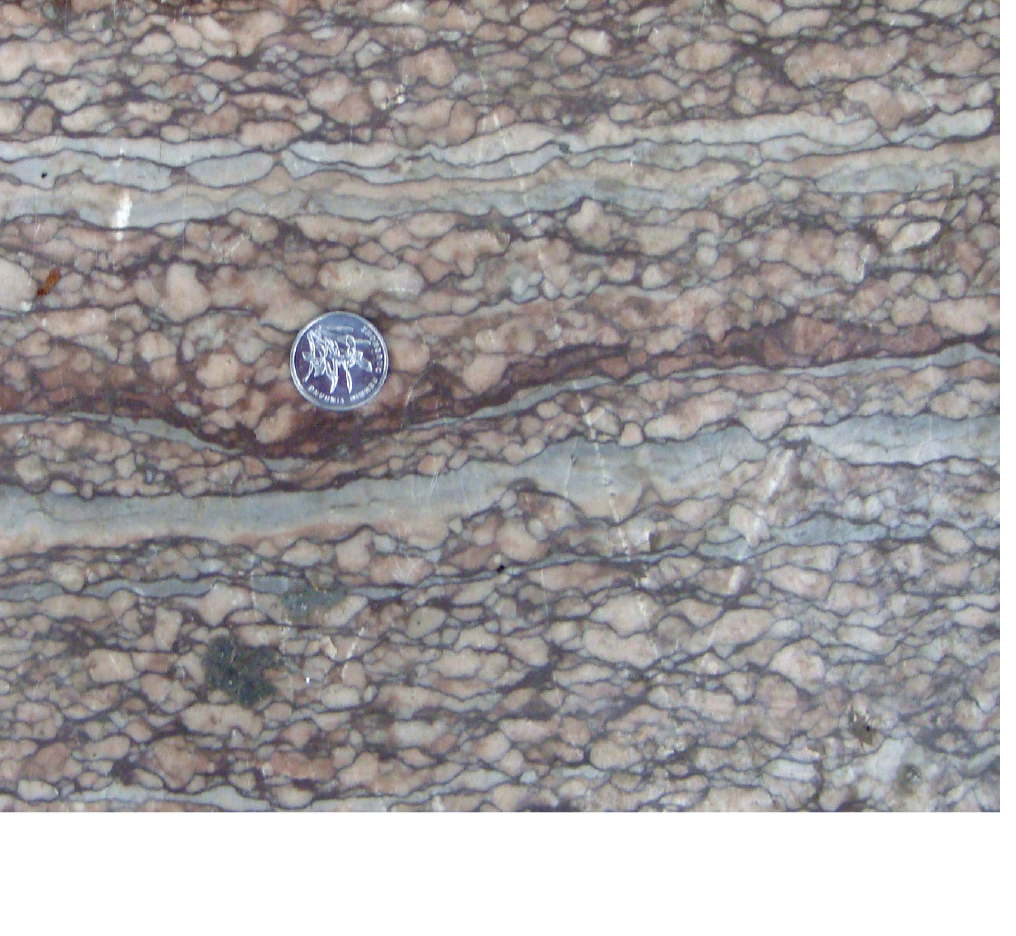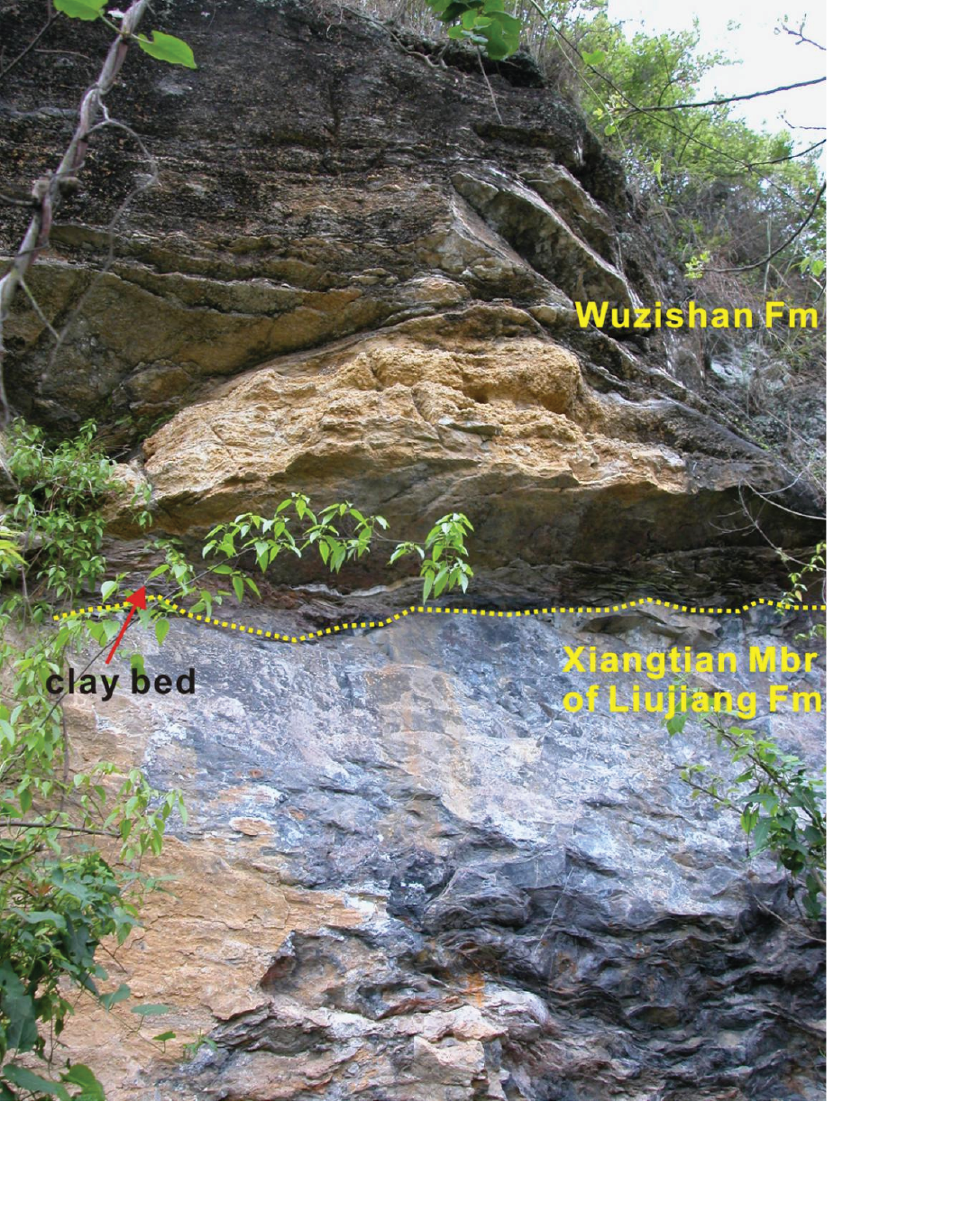Wuzhishan Fm
Type Locality and Naming
The type section is located at Wuzhishan (mountain), east of Dachang town of Nandan County, Guangxi. It was named by Zhang Zhaojin in 1941. Wu Y. et al. (1988) measured the type
section in the Yangjiaoshan hill, 1 km of northwestern Wuzhishan Mt.
Lithology and Thickness
Nodular clayey limestone. The lithological character is dominated by two kinds of wackestone. One is light-gray to gray medium- to thin-bedded argillaceous banded (stripe) limestone with thin marl interbeds. The other one is characterized by the nodular or lenticular limestone, partly intercalated with breccia limestone displaying slide and slump structures. The nodular varies in size from 2 to 20 mm, and in form from irregular nodular to sausage shape. The color varies in gray, light red and red purple. Generally the lower part shows more banding, whereas the upper part is more nodular. Locally, banded volcanic tuffs in millimeter thickness can be seen. Stylolites are common both in the nodular and stripe limestones. The formation is 100-150 m in thickness.
In Xiangzhou to Hengxian line, the base of this formation often has a pebble-like limestone, which has been named Xiangshan Member (Hou Hongfei et al., 1988), and a bed of black nodular limestone is developed between it and the nodular limestone.
[Figure: Polished slab showing the nodular limestone of Wuzhishan Formation, which forms beautiful ornamented stone used as building materials (collected from Baisha Quarry), diameter of coins is 1.9 cm.]
[Figure: Outcrop of nodular limestone of Wuzhishan Formation near the entrance of G355 Highway of Xiangzhou County]
Relationships and Distribution
Lower contact
The formation has a basal conformable contact to the underlying siliceous rocks of the Liujiang Fm, and is marked by the appearance of nodular or banded limestone. In some areas such as at Laohudong Hill near Xiangtian village, about 1km west of Luoxiu Town, Xiangzhou County, there is a set of brecciated limestone, black detrital limestone, marlstone and clay beds to form a peculiar Xiangtian member intercalated within Liujiang and Wuzhishan Formations (Hou Hongfei et al., 1988), The base of Wuzhishan Fm is marked by a bed of clay, in which exhibits iridium anomalies, positive 13C excursion and enrichments of other geochemical elements, corresponding to Upper Kellwasser Event. The conodont shows that the basal Wuzishan Formation can correlate to the boundary of Frasnian and Famennian.
[Figure - boundary between Liujiang and Wuzhishan Formations at Luoxiu of Xiangzhou, Guangxi. Based on the entry of Palmatolepis triangularis, the base of Unit F (clay bed) of Wuzhishan Formation is corresponding to the Frasnian-Famennian boundary.]
Upper contact
The formation has a The formation has a disconformable contact with the overlying black shale of the topmost Devonian (Hangenberg event) then the Luzhai Fm of Lower Carboniferous (or Yanguan Fm, Yaoyunling Fm, Duan Fm depending on region)
Regional extent
This formation is widely distributed over Guangxi, southern Guizhou and southeastern Yunnan with relative stable lithology and thickness. In the Delong, Malang, Pohe of Napo County, Mukui of Guiping, Dachang of Nandan in Guangxi the formation contains trachyte, spilite keratophyre and felsite etc., suggesting a submarine volcanism.
GeoJSON
Fossils
There are a few mega-fossils in the formation. At Nandan of Guangxi can be distinguished the Ammonoid Clymenia and Wocklumenia zones, and Trilobite Dianops-Typhloproetus assemblage zone. Conodonts are very abundant and include the Palmatolepis gigas zone to Siphonodella praesulcata zone. The section at Zhaisha of Guangxi yields ammonoid Sporadoceras etc. At Luofu of Nandan and Lanxu of Daxin area, it contains ostracoda Ungerella sigmoidle, Entomozoe nehdensis etc.
[Figure . Distribution of conodonts from the Wuzhishan Formation in Yangjiaoshan hill, 1 km of north-western Wuzhishan Mt. Of Dachang, Nandan (data after Wu, Y., 1992).]
Age
Depositional setting
It is interpreted as a deep-water basin (deep shelf) and slope deposits. The Wuzhishan Fm of Delong, Malang, Pohe, of Napo County, Mukui of Guiping, Dachang of Nandan in Guangxi contains trachyte, spilite keratophyre and felsite etc. This would suggest submarine volcanism during the Famennian.
Additional Information
The Wuzhishan Fm records two important geological events:
The first is the Frasnian-Famennian biological event, which is at the base of the Formation, and widely recognized in southern China. Around this level at Luoxiu of Xiangzhou, Guangxi, the F-F boundary sedimentary sequence possesses brecciform limestone, black shale and nodular limestone, with excursions of carbon and oxygen isotopes and iridium element (Hou et al., 1988, Wang et al., 1991, Hou et al., 1992, Yan et al., 1993).
The other event is in the topmost Wuzhishan Fm where there commonly is a unit of black shale, with maximum thickness of about 1 m, that is well developed in Changshun, Mawei of Dushan, Guizhou, Nandan, Shanglin of Guangxi. This event horizon is named the Changshun Shale (Wang Chengyuan, Yin Baoun 1984, Acta Palaeon. Sinica) or Gedongguan Bed (with a link called Gedongguan Bed Fm in this database system) (Hou Hongfei et al., 1985, Courier Forsch. Senck.). The shale is correlated to the Hangenberg anoxic event and global crises near the Devonian-Carboniferous boundary.



